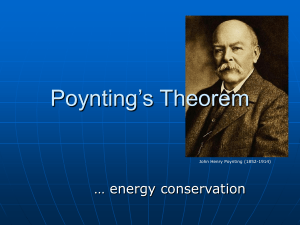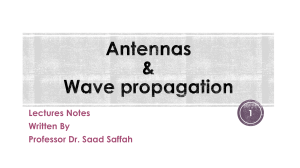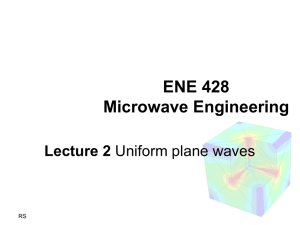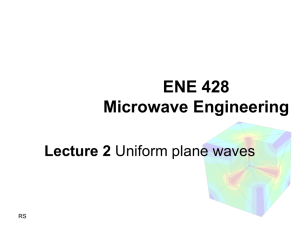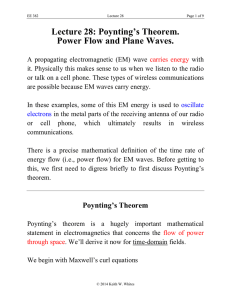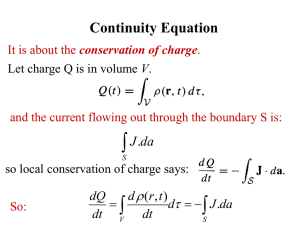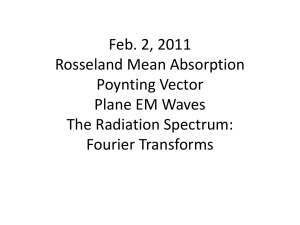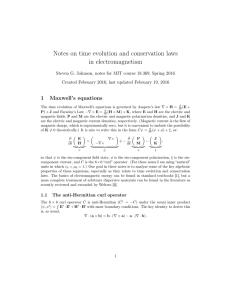ENE 429 Antenna and Transmission Lines
advertisement
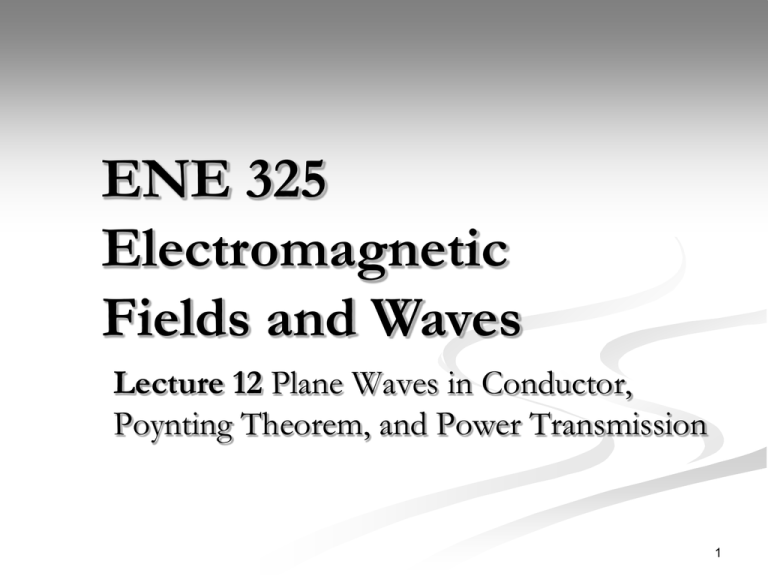
ENE 325 Electromagnetic Fields and Waves Lecture 12 Plane Waves in Conductor, Poynting Theorem, and Power Transmission 1 Review (1) Wave equations 2 E E 2 E 2 t t 2 H H 2 H 2 t t Time-Harmonics equations 2 E s 2 E s 0 2 H s 2 H s 0 where j( j ) 2 Review (2) where j( j ). This term is called propagation constant or we can write = +j where = attenuation constant (Np/m) = phase constant (rad/m) 3 Review (3) The instantaneous forms of the solutions E E0 e z cos(t z )a x E0e z cos(t z )a x H H 0 e z cos(t z )a y H 0e z cos(t z )a y The phasor forms of the solutions E s E0 e z e j z a x E0e z e j z a x incident wave reflected wave H s H 0 e z e j z a y H 0e z e j z a y 4 Attenuation constant Attenuation constant determines the penetration of the wave into a medium Attenuation constant are different for different applications The penetration depth or skin depth, is the distance z that causes E to reduce to E0e1 z = -1 z = -1/ = -. 5 Good conductor 1 1 f At high operation frequency, skin depth decreases. A magnetic material is not suitable for signal carrier. A high conductivity material has low skin depth. 6 Currents in conductor To understand a concept of sheet resistance from L 1 L R A wt 1 L R Rsheet () L t w w Rsheet 1 t sheet resistance At high frequency, it will be adapted to skin effect resistance 7 Currents in conductor E x E x 0 e z J x E x 0 e z Therefore the current that flows through the slab at t is I J x dS ; ds dydz 8 Currents in conductor From I J x dS ; ds dydz w I Ex 0 e z dydz z 0 y 0 w Ex 0e z I w Ex0 0 A. Jx or current density decreases as the slab gets thicker. 9 Currents in conductor For distance L in x-direction V Ex0 L R Ex 0 L V 1 L L Rskin I w Ex 0 w w R is called skin resistance Rskin is called skin-effect resistance For finite thickness, t w I Ex 0e z dydz w Ex 0 (1 e t ) z 0 y 0 Rskin 1 (1 et / ) 10 Currents in conductor Current is confined within a skin depth of the coaxial cable. 11 Ex1 A steel pipe is constructed of a material for which r = 180 and = 4106 S/m. The two radii are 5 and 7 mm, and the length is 75 m. If the total current I(t) carried by the pipe is 8cost A, where = 1200 rad/s, find: a) skin depth b) skin resistance 12 c) dc resistance 13 The Poynting theorem and power transmission Poynting theorem 1 2 1 2 (E H ) dS J E dV t 2 E dV t 2 H dV Total power leaving Joule’s law the surface for instantaneous power dissipated per volume (dissipated by heat) Rate of change of energy stored In the fields Instantaneous poynting vector S EH W/m2 14 Example of Poynting theorem in DC case 1 2 1 2 (E H ) dS J E dV t 2 E dV t 2 H dV Rate of change of energy stored In the fields = 0 15 Example of Poynting theorem in DC case From I J 2 az a By using Ohm’s law, J I E 2 az a a 2 L I2 d d dz 2 2 ( a ) 0 0 0 1 L 2 I I R 2 a 2 16 Example of Poynting theorem in DC case Verify with EH dS From Ampère’s circuital law, H dl I 2 aH I H I 2 a a 17 Example of Poynting theorem in DC case I I I 2 S E H 2 az a 2 3 a 2 a a 2 a Total power I 2 S d S 2 3 a d dz 2 a I 2 a 2 L I 2 L 2 2 3 d dz I R 2 2 a 0 a 0 W 18 Uniform plane wave (UPW) power transmission Time-averaged power density Pavg 1 2 W/m Re( E H ) 2 P Pavg d S Ex 0 j z 1 j z for lossless case, P avg Ex 0e ax e ay 2 1 Ex20 P avg az W 2 amount of power 19 Uniform plane wave (UPW) power transmission for lossy medium, we can write E Ex 0e z e j z e j a x intrinsic impedance for lossy medium e H 1 a E 1 jn a z Ex 0e z e j z e j a x Ex 0 e z e j z e j e jn a y 20 Uniform plane wave (UPW) power transmission from Pavg 1 Re( E H ) 2 1 Ex20 2 z j Re e e az 2 1 Ex20 2 z e cos a z 2 W/m2 Question: Have you ever wondered why aluminum foil is not allowed in the microwave oven? 21
